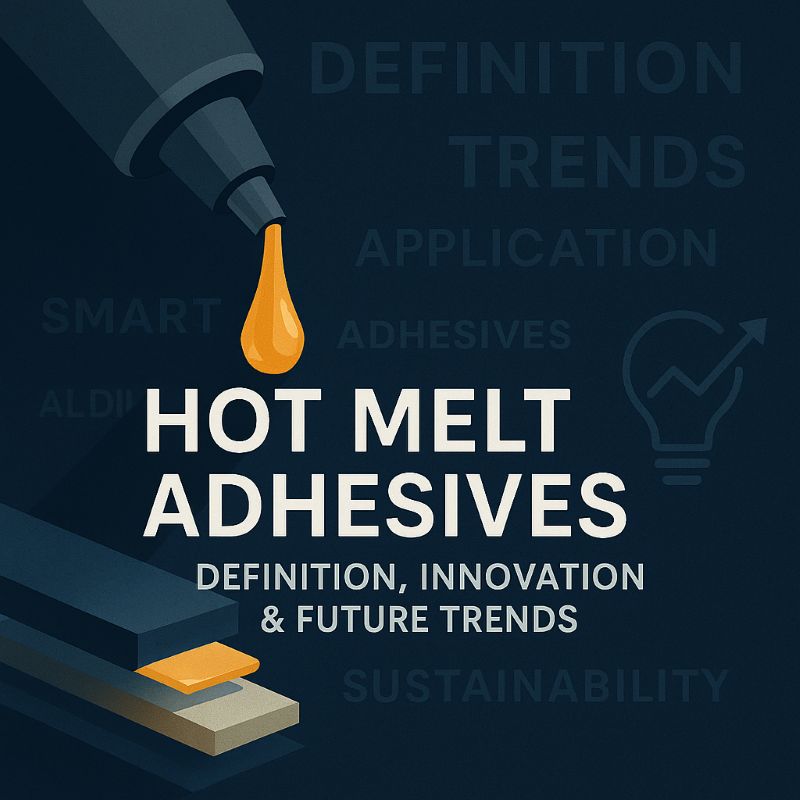
Defining Hot Melt Adhesives
Types of Hot Melt Adhesives
Importance in Modern Applications
Innovative Application Methods
Latest Trends in Adhesive Tech
Strategies for Optimal Use
Future of Hot Melt Adhesives
Frequently Asked Questions (FAQ)
Hot melt adhesives are thermoplastic bonding agents that are applied in molten form and solidify quickly upon cooling, creating strong, reliable bonds. Their fast setting times and compatibility with a wide variety of materials make them essential in industries such as packaging, woodworking, and automotive assembly. These adhesives are known for their efficiency, clean application, and durability—making them a trusted component in high-speed production environments.
Understanding the types of hot melt adhesives is key to choosing the right formulation for specific applications:
EVA (Ethylene Vinyl Acetate): Widely used for packaging and general bonding due to its balance of cost and versatility.
Polyamide: Offers excellent heat resistance and mechanical strength, suitable for applications involving high temperatures or chemicals.
Polyolefin: Delivers strong bonding on various substrates, including plastics and wood, commonly used in automotive and furniture manufacturing.
Reactive Hot Melt (e.g., PUR): Forms moisture-curing, highly durable bonds ideal for challenging or dynamic environments.
Each type offers distinct properties tailored to different industrial requirements, supporting both standard and demanding applications.
Hot melt adhesives are crucial to modern production across industries due to their speed, strength, and reliability. They help streamline manufacturing workflows by eliminating long curing times, reducing waste, and improving bond consistency. In automotive manufacturing, they enable bonding of dissimilar materials, enhancing both safety and design flexibility. In packaging, woodworking, and electronics, hot melt adhesives support rapid throughput while maintaining product integrity.
Modern application techniques are expanding the utility of hot melt adhesives:
Spray Application: Allows even coverage over large or irregular surfaces.
Slot Die Coating: Enables controlled, uniform adhesive layers—ideal for laminating and continuous bonding.
Automated Dispensing Systems: Improve speed and consistency on production lines.
Precision Nozzles: Reduce stringing and waste in detailed bonding operations.
These innovations maximize efficiency, reduce material usage, and open new design possibilities across sectors.
Hot melt adhesive technology is evolving with a strong focus on performance and sustainability:
Eco-Friendly Formulations: New adhesives are being developed with low-VOC, non-toxic ingredients to support environmentally conscious production.
Advanced Substrate Compatibility: Enhanced formulations improve bonding to difficult surfaces like oily metals and engineered plastics.
Smart Systems Integration: Some dispensing systems now feature real-time monitoring and control to optimize adhesive flow and reduce waste.
These trends signal a future of greener, more adaptive, and more intelligent bonding solutions.
To make the most of hot melt adhesives in your operations:
Match Adhesive Type to Application: Choose based on substrate, temperature exposure, and performance requirements.
Maintain Application Equipment: Ensure stable temperatures and flow for consistent bonding.
Use Efficient Application Methods: Automated systems or precision tools reduce waste and improve accuracy.
Monitor and Optimize: Track performance and adjust settings to improve throughput and reduce downtime.
A strategic approach to adhesive selection and use can dramatically improve production outcomes and cost-efficiency.
The hot melt adhesive industry is heading toward smarter, more sustainable, and more versatile solutions:
Sustainability: Development of recyclable and biodegradable adhesive systems.
Efficiency Gains: Lower energy usage through low-temperature melt formulations.
Technological Integration: Smart adhesives that self-monitor application rates or adjust viscosity in real time.
These advancements are expected to redefine performance benchmarks and support global manufacturing sustainability goals.
Q: What are hot melt adhesives?
A: They are thermoplastic materials applied in molten form that solidify upon cooling, offering quick and durable bonding.
Q: What are the main types of hot melt adhesives?
A: EVA, polyolefin, polyamide, and reactive types, each tailored to specific bonding needs and industries.
Q: Why are hot melt adhesives important?
A: They reduce production time, improve bond quality, and are compatible with automated systems.
Q: What application techniques are used with these adhesives?
A: Common methods include spray, slot die, and automated dispensing, depending on the use case.
Q: What trends are shaping the adhesive market?
A: Sustainability, smart dispensing systems, and improved substrate compatibility are major trends.
Q: How can I optimize adhesive use?
A: By selecting the right type, maintaining equipment, using efficient application tools, and training personnel.
Q: What does the future look like for hot melt adhesives?
A: It includes smart technologies, greener chemistry, and higher efficiency in production settings.